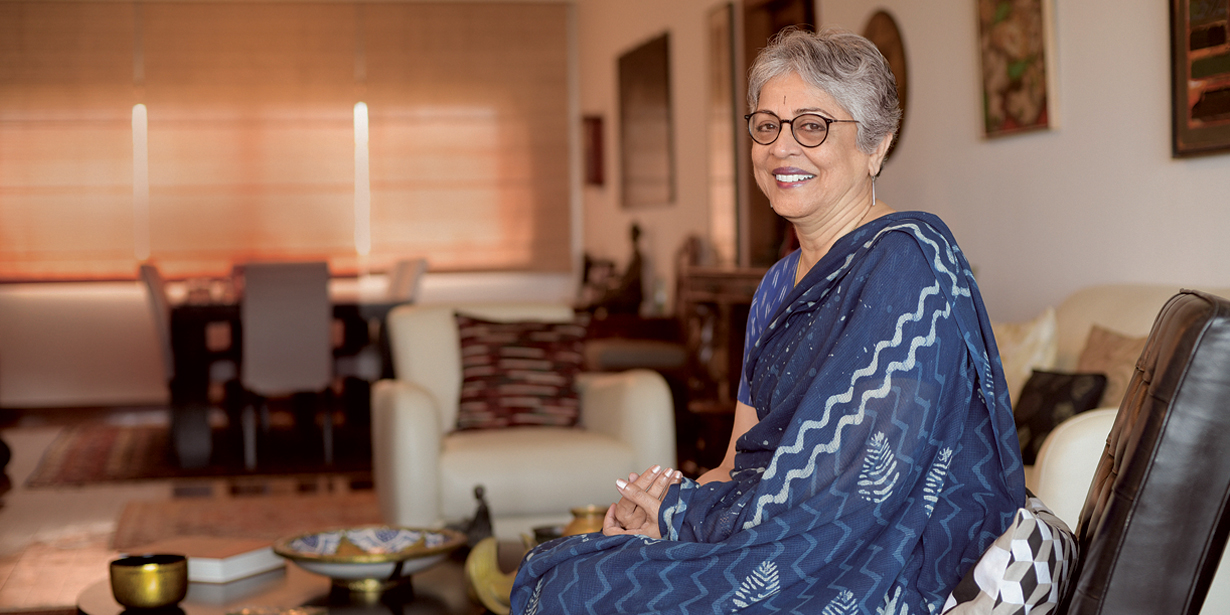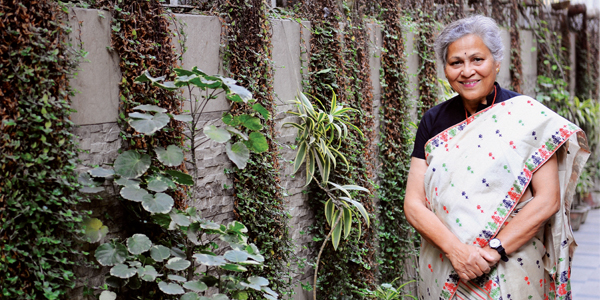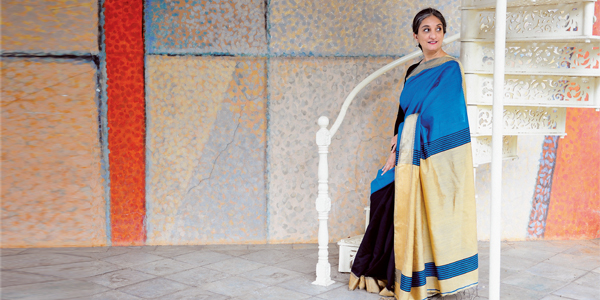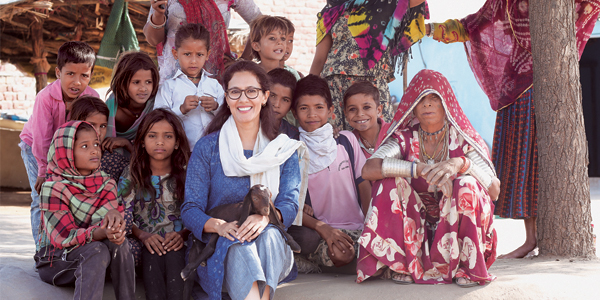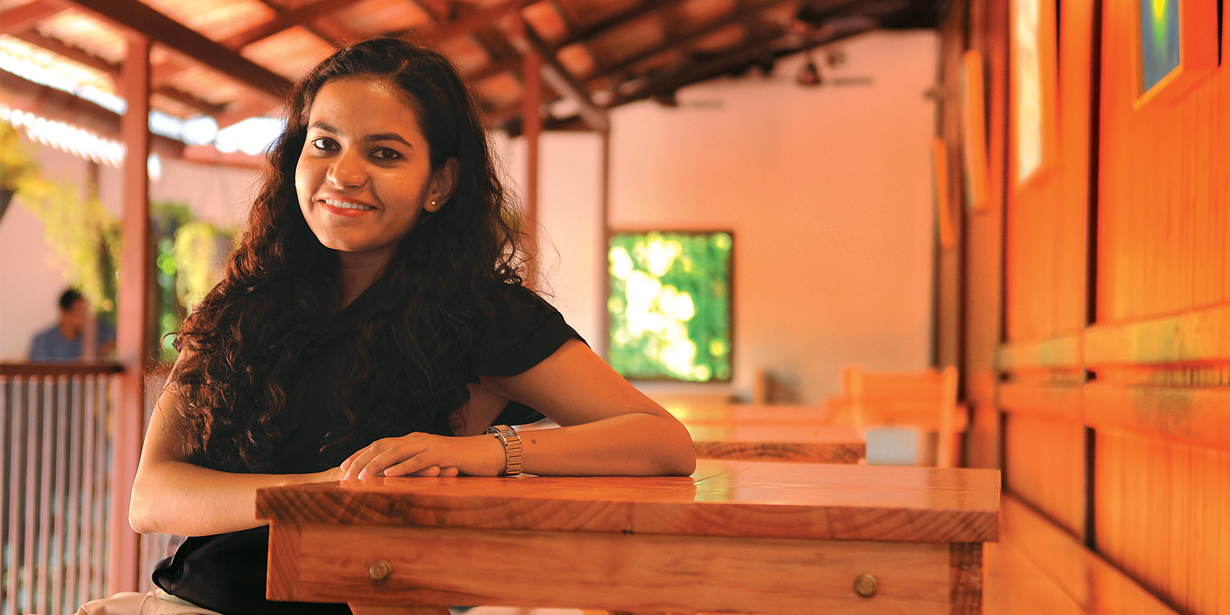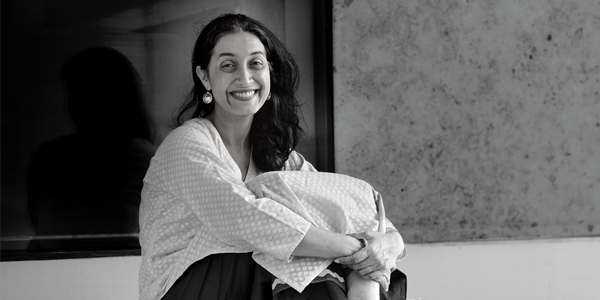One of India’s topmost architects, whose design sense had won the heart of Vijay Chauhan at just 24
Design doyenne Brinda Somaya’s 40-year-old practice is a masterclass in balancing difficult choices with sharp business acumen
Among a neatly organised line-up of personal photos on a corner wall of this principal architect’s office is an arresting black-and-white portrait of a woman leaning against a corridor railing. It isn’t a remarkable picture, but one can’t help but admire the simplicity of the woman photographed. Her average height and supple figure is complemented by a voluminous plaited mane that’s competing with her sari pallu for length. All of it belying the fiery potential behind her unassuming poise.
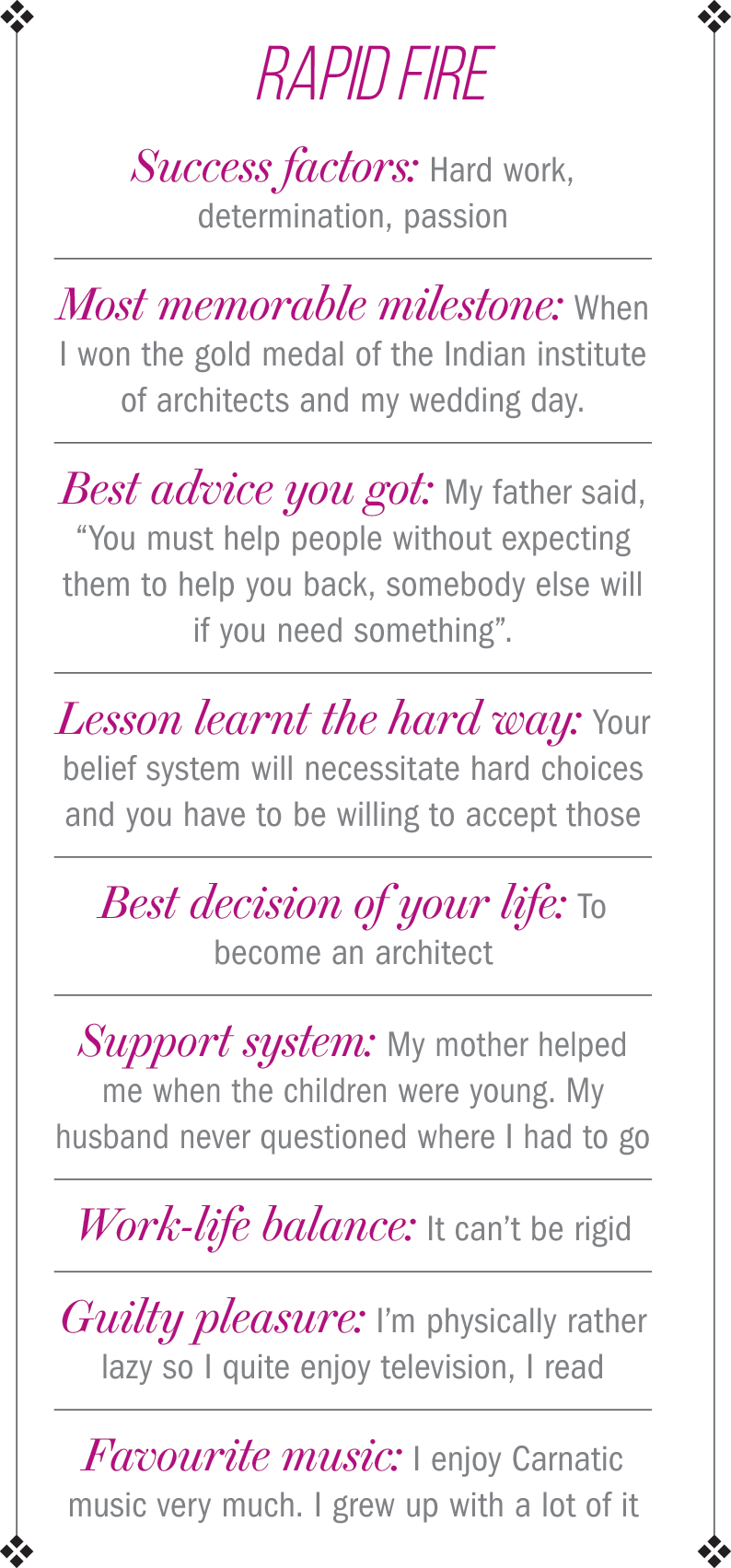 It was around the late 1970s that Vijay Chauhan of Parle Products picked up on the creative streak of the then 24-year-old architect. It was when she presented a plan to the committee at the Bombay Presidency Golf Club for a swimming complex, that he offered her the job to work on one of the factories. For the newly married army wife, this was just the unexpected break she needed. She was being paid Rs.800 in recognition of her US education, but wasn’t particularly happy at the firm she worked for. “The Chauhan family had the confidence to give a young sari-clad woman an industrial project to do. It was only a part of a factory back then, but today, 40-years later, they are still my clients,” beams Brinda Somaya, founder, Somaya and Kalappa Consultants.
It was around the late 1970s that Vijay Chauhan of Parle Products picked up on the creative streak of the then 24-year-old architect. It was when she presented a plan to the committee at the Bombay Presidency Golf Club for a swimming complex, that he offered her the job to work on one of the factories. For the newly married army wife, this was just the unexpected break she needed. She was being paid Rs.800 in recognition of her US education, but wasn’t particularly happy at the firm she worked for. “The Chauhan family had the confidence to give a young sari-clad woman an industrial project to do. It was only a part of a factory back then, but today, 40-years later, they are still my clients,” beams Brinda Somaya, founder, Somaya and Kalappa Consultants.
All it took was a few solo projects for Somaya to gain the confidence of setting up her own practice. And as luck would have it, she even found the right partner to start her entrepreneurial venture with. In 1978, Somaya’s elder sister, Ranjini Kalappa, a JJ School of art and Pratt Institute of Architecture alumni, returned to India. And that’s how the Chinappa (maiden name) sisters set up their design studio in a tiny garden shed in Mumbai. “We had hired one architect to work with us part-time, and once I remember going to the office in the afternoon to find him asleep, because we hadn’t much work initially,” she recalls. Soon enough that changed, Somaya went on to hire three more permanent hands, but in 1980, had to let go of her co-founder, who moved base to Europe.
Strong Foundation
She missed her elder sibling, but there were more pressing problems for the young entrepreneur. Jostling with bureaucracy was one of them. “I remember waiting outside a municipal office in Bandra (suburban Mumbai) for three days, where not even the peon would come to greet me. They kept saying they couldn’t find my files,” she says, recounting her sense of dismay. This didn’t last too long, for she was soon advised by a friend of the impenetrable red tape and how she would have to hire help to get the job done.
Taking risks and making bold decisions was something Somaya had been doing all her life. Be it opting for a course in architecture at a time when women comprised of only 10% of the class; or packing a suitcase and flying off to the United States for a year on a student-exchange programme as a 16-year-old; or even backpacking across Europe for three months on a daily $5-budget and sleeping at railway stations; Somaya never saw it as bravado, but a way of life. Perhaps it was the result of her childhood travails thanks to her parents – for Bengaluru-born Somaya, summer holidays were an opportunity to pen down stories of adventure as her family travelled across the length and breadth of the country. “I still remember I was only eight-years-old when my parents took me and my sister to see the ancient ruins of Nalanda University in Bihar. I can recount the brickwork and the beauty of the building and the monastery,” she says of the experience that implanted the idea of archaeology and later architecture as a profession. The 69-year-old architect, who has travelled to numerous countries so far, attributes her love for travel to her parents.
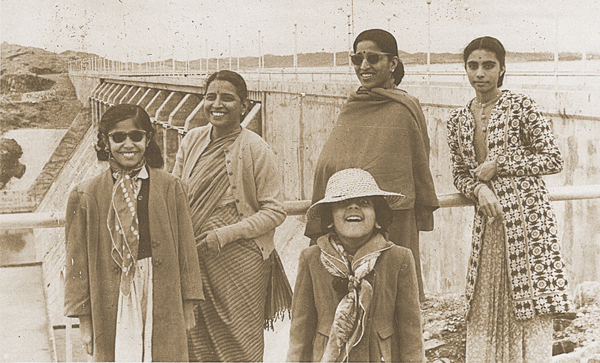 And she also attributes her academic trajectory and later successful career to the freedom they encouraged. “I think in families where there are only daughters, you are given every opportunity. When we were growing up, there was no question of just getting married and sitting at home. Education was important, my father, an engineer, would wake up at five to teach me physics and my mum, a zoologist, would teach me chemistry. They were concerned but they never stopped me from doing anything,” she describes her childhood. Somaya found a life partner, currently a cardio-vascular surgeon, who remains till this date a “silent supporter”, who didn’t question her travel commitments or time spent at work.
And she also attributes her academic trajectory and later successful career to the freedom they encouraged. “I think in families where there are only daughters, you are given every opportunity. When we were growing up, there was no question of just getting married and sitting at home. Education was important, my father, an engineer, would wake up at five to teach me physics and my mum, a zoologist, would teach me chemistry. They were concerned but they never stopped me from doing anything,” she describes her childhood. Somaya found a life partner, currently a cardio-vascular surgeon, who remains till this date a “silent supporter”, who didn’t question her travel commitments or time spent at work.
Famed Blueprint
When one sits down to chronicle the work of this architect across four decades, you’d discover that it does not all fall under one category. For instance, one look at Mumbai’s skyline in the formerly congested mill area of Lower Parel reveals the evolution of the city and her practice. Conservation, city, culture, community and contemporary – the five Cs as Somaya likes to call them – define her extensive body of work.There are the residential projects, then the hospitality projects for Club Mahindra and other properties such as Taj West End Bangalore, the UNESCO-awarded restoration of St John’s Cathedral, the campuses of Tata Consultancy Services across the country. The firm has collaborated with New York based architectural firm Pei Cobb Freed & Partners for the World Towers at Lower Parel and is working on the restoration of India’s most prestigious academic institutions, IIT Bombay and IIM Ahmedabad.
Of course, the most recent conservation work that grabbed headlines early this year was the iconic headquarters of salt-to-software conglomerate, Tata – Bombay House in south Mumbai. “It was one of the most challenging projects we had undertaken, not in terms of design but the timeline. The chairman, N Chandrasekaran, wanted us to complete it by July on JRD Tata’s birthday. And once the building was emptied out, we had only seven months. It seemed impossible, but we did it. The chairman met us at regular intervals but he also gave us a lot of freedom,” she concludes modestly, although it’s hard to miss the sense of pride behind that smile.
And when you ask Somaya what factors she attributes her success to, the instant response is “clients who believed in me”. She elaborates, “I didn’t play golf or socialise in a bar or club to get clients. It was the body of work built over the years that gave clients the confidence to choose us,” she says. That coupled with a no-compromise-on-ethics policy has earned SNK, as the studio is branded now, its reputation. However, that has not always meant they got the job. Somaya recalls the one business lesson she learned the hard way. “Once, I was too frank with a client as I was not content with what was happening integrity-wise with the project, and I said so. I lost that project, which I don’t regret. But, what that taught me is that sticking to your values will sometimes necessitate hard choices that you must be willing to accept,” she says. And that’s a policy she maintained, even when plum government projects that her studio had pitched for slipped away, because she and her team refused to appease the authorities in the capital city.
Apart from ethics, if there’s another aspect where Somaya is uncompromising, then it’s the remuneration. “Running a creative practice as a business is tough. Architects under quoting each other is only damaging the profession. We tell clients that we don’t make any money other than our fee, and if we don’t get the fee that enables us to run this organisation the way we want to, then we don’t take up the job,” she says. Somaya manages a team of over 50 architects, designers, engineers and quantity estimators with her lawyer-turned-architect daughter. According to Zauba Corp, the firm clocked a revenue of nearly Rs.110 million in FY18.
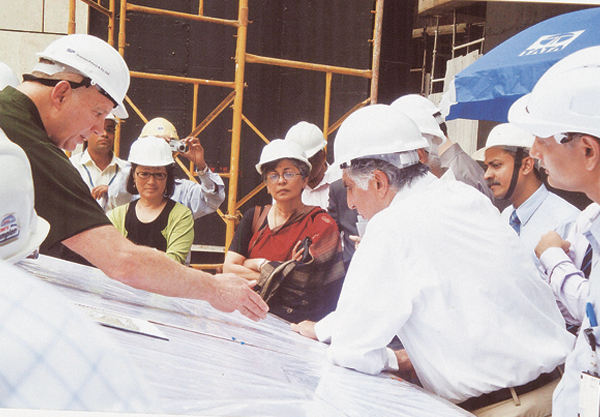 Not undermining the value she brings to the table is something Somaya maintains even when she is working with world-renowned architects, through collaborations.
Not undermining the value she brings to the table is something Somaya maintains even when she is working with world-renowned architects, through collaborations.
She believes a partnership can last long and benefit both parties, her longest one being a 13-year-old working relationship with husband-wife duo Tod Williams and Billie Tsien, who won the contract for the Barack Obama Presidential Library in Chicago. Somaya says, “Expertise that will come in from the other side, but in a collaboration, one must not diminish one’s own creativity. In our studio, we are very discerning of whom we collaborate with and for which project. And only two to three projects will be collaborative work,” she explains.
New heights
When she’s not toiling away at her desk or on site, Somaya makes time for some academic and industry work. She’s currently the only Indian among 20 names listed as an AD White professor at Cornell University and she’s on the master jury of Zurich-based LafargeHolcim Foundation for Sustainable Construction. She’s received an honorary doctorate from Cornell University. And, she’s been successful in creating a network of women architects who call upon each other for professional advice. The grandmother of four confesses, “I was never not working. Even three days before my first child was born, I was on site.”
It is inspiring to see how she still finds it extremely exciting to wake up every morning to head to work. And she’s quick to correct us when we ask for her final words on her work, “Architecture for me is not work, it’s now become part of my life.”
